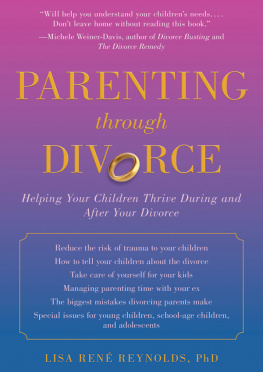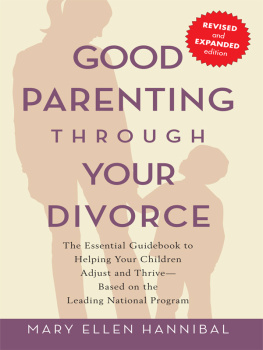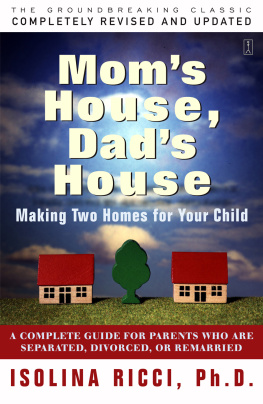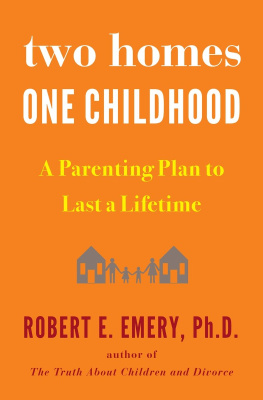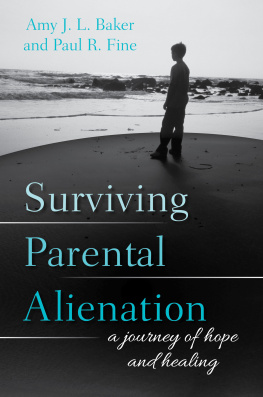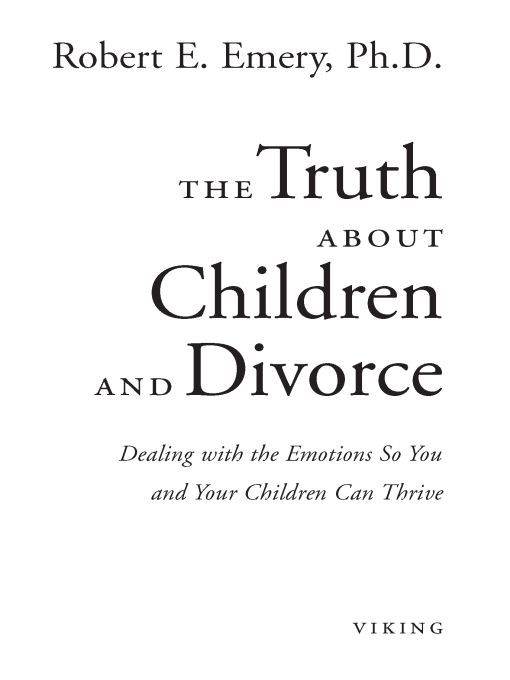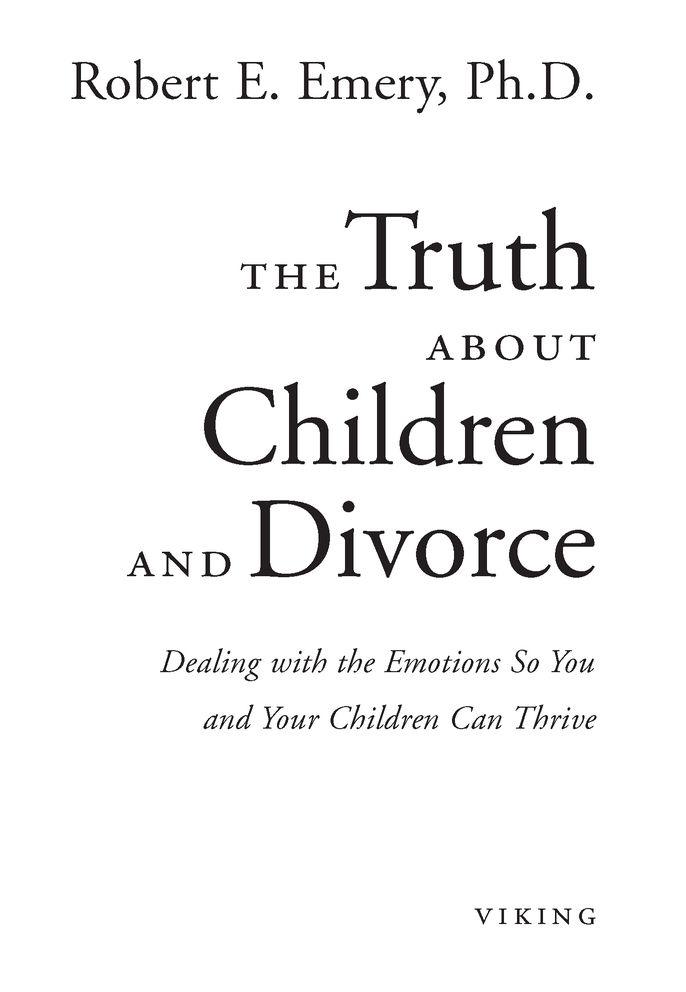Table of Contents
This book is dedicated to all of the parents and children who have opened their hearts to me, shared their pain, and shown their strength.
Acknowledgments
My overriding goal in writing this book has been to reach parents and children lost in the hurt, pain, sadness, uncertainty, and grief of divorce. I hope that the insights and the stories of others who have shared your struggles can help you through this crisis and guide you to a better place as a person and as a member of a family, albeit a family apart. If this book touches you, you can thank, as I do here, the many people who have shared their stories and, most important, their emotions with me as clients, as participants in various research studies, and as friends. I have learned so much from you.
I also especially want to thank Beth Vesel, my agent, who was instrumental in assisting me in turning my desire to help into this book and who along the way was an advocate, a confidante, and a gentle but incisive critic. I extend equally warm feelings of gratitude to Patty Ro manowski Bashe, who acted as editor/writer and with great humor and perseverance taught me how to relax my academic style and encouraged me to write more like I think, talk, and feel. I also offer my warm gratitude to my editor, Janet Goldstein, who from the outset believed in my work and what I wanted to share and who at times had a better sense than I did of where this book needed to go. Associate editor Lucia Wat son effectively managed innumerable details in writing style and organization in bringing this book to fruition, and I thank her too for her thoughtfulness and efficiency.
I have been extremely lucky over the course of nearly twenty-five years to have terrific graduate students who worked extremely hard, helped me to refine my ideas, and shared their original thinking and experiences with me. Lisa Laumann-Billings, Dave Sbarra, Mary Waldron, and Pete Dillon played central roles in recent studies, many of which are discussed in this book. The mediation study began almost two decades ago, however, and I want to acknowledge and thank past students Susan Peterman, Dan Shaw, Melissa Wyer, Susan Joyce, Jeff Haugaard, Sheila Matthews, Shelly Tuer Martin, Katherine Kitzmann, and Mary Jo Coiro. I also want to thank Joanne Jackson, the principal mediator in the early days of the mediation study, and Catherine McLamb, a student whom I took a special interest in and who, in turn, has taken a special interest in this book.
The William T. Grant Foundation has been like a generous relative over the years, supporting not only my research but also my ideas. The distinguished members of the W. T. Grant Foundations Divorce Consortium especially helped to shape my thinking in our unique and lively gatherings, as have my friends and colleagues at the University of Virginia. I especially want to single out Mavis Hetherington, with whom I probably talked more while traveling away from Charlottesville than during our twenty years in the same department.
I also want to give special thanks to two friends/colleagues who provided very helpful comments on drafts of this manuscript, Alice Licata and Jan Pryor.
Growing up, my sisters, Susan and Kristan, said that we spelled family with a capital F, and we did. I grew up in an extended Italian American family where everyone worked in the same business and everyone got into one anothers business. My parents were married for fifty-seven years. I miss my father, who died in 2001, and want my sometimes-overinvolved but always loving mother, Mickey, to know how much I love her too. My deepest love and gratitude go to my wife, Kimberly, for pushing me, keeping up with me, and keeping things more than interesting, and, of course, to my five children. I have learned far more from Maggie, Julia, Bobby, Lucy, and John than from any textbook, especially the hard work, the joys, and ultimately the limits of parenting. For this book, special praise goes to Maggie, who went through my divorce and came out stronger on the other side.
Authors Note
All of the cases described in this book are composites. Extensive details have been changed to protect the confidentiality and privacy of my clients and research participants. The cases in the book are emotionally real, but no case corresponds to any actual person, living or dead.
INTRODUCTION
Putting Children First When a Marriage Comes Apart
The telephone call was typical of many that I receive as a marriage therapist and mediator. After fourteen years of marriage, Danielle and Frank were separating. Normally, only one partner calls to make the first appointment. Its usually the one who wants out of the marriage. I know to listen carefully to the callers version of events while bearing in mind that in marriage there are at least two, and sometimes even more, sides to the story. What was different here was the timingjust a week before Christmas, an understandably unpopular time for separationsand the timetable Danielle had set for the split: now.
As a psychologist and a dad myself, I found this especially distressing since the couple had a six-year-old child, Sam. Danielle and Frank had each met with lawyers, but Danielle told me that sheand, she hoped, Frankdidnt want to go that route. They both made the same amount of money, so they werent going to be fighting over finances. Even though Frank wanted to work things out, Danielle said, there was little chance of saving the marriage now.
Could you please meet with us before Christmas? she asked urgently.
After we agreed on a date, Danielle offered some additional, crucial background: She had only recently confessed to Frank that she was having an affair. She was worried about what Frank might do. Whenever she tried to talk seriously about separation, he made it very clear that he wanted to have Sam with him all the time. Danielle said this was a ridiculous suggestion. After all, she had spent more time raising Sam, and she loved him so much. She couldnt stand being apart from him. But Danielle also felt guilty and uncertain about what was right and what might happen legally. After all, she was having an affair. As I penciled in the appointment, I wondered how much Christmas spirit any of us would be feeling by the time they left.
Later, as I read through my notes from the conversation, I saw that Danielle and Frank had all the ingredients for a volatile and ugly divorce: a one-sided separation, the surprise and betrayal that comes with a partners affair, a rush to accomplish in a matter of days the tasks of separation that typically take months or even years, potentially adversarial lawyers, and terrible timing. What could be worse for young Sam than his parents separating over Christmas break? There was no question that as former partners and future exes, Danielle and Frank were in for a rough time. Despite all this, though, I hoped that one thing Danielle had told me on the telephone would hold true: that she and Frank shared an abiding love and concern for Sam.
ReallyPutting Kids First
Sometimes I wonder why I put myself in the middle of the agonyand the angerof couples like Danielle and Frank. As a psychologist, mediator, researcher, and college professor known for my twenty-five years of scientific studies and work on families and divorce, I could choose to remain in the academic realm rather than jump into the fray and fury of divorcing couples.



